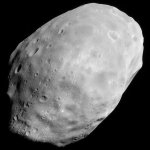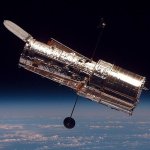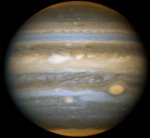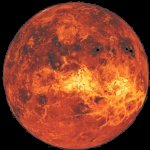



Summary of results:
Maria Mitchell's score on this quiz was 80% (any incorrect choices are highlighted in red).
#1. Rank the following objects from smallest to largest.
#2. Do atoms have substructure?
#3. When the nuclear reaction shown below takes place, does the amount of mass involved stay constant (is mass conserved)?
#4. Why does the fusion process in the solar core produce energy?
#5. The Moon is traveling at a speed almost equal to the escape velocity for an object at this distance from Earth. If it moved further from Earth, it would need to move at a rate its current speed to maintain a stable orbit.
Elapsed Time: 22.88 minutes
#1.
Rank the following objects from smallest to largest.| [A] |  |
[B] |  |
| [C] |  |
[D] |  |
| B – A – C – D | D – A – C – B |
| A – D – C – B | B – A – D – C |
The four objects, are [A] the Martian moon Phobos, [B] the Hubble Space Telescope, [C] planet Jupiter, and [D] planet Venus. (Like the astronomical photos? Credit NASA.)
How can we estimate their relative sizes? The Hubble Space Telescope is the size of a school bus, and Phobos, an asteroid that ventured too close to Mars and was captured into orbit, is a small-sized moon. The Terrestrial planets (Mercury, Mars, Venus, and Earth) are all smaller than the gas giants (Uranus, Neptune, Saturn, and Jupiter).


#2.
Do atoms have substructure?| Yes, an atom has a firm exoskeleton surrounding a squishy center, like an insect. |
| Yes, an atom is made up of light particles called protons and neutrons, and heavy particles called electrons. |
| No, an atom is the fundamental building block of matter. |
| Yes, an atom is made up of heavy particles called protons and neutrons, and light particles called electrons. |
Atoms contain one or more protons and one or more neutrons, in their central core (the nucleus). The heavy core is surrounded by a cloud of one or more electrons.


#3.
When the nuclear reaction shown below takes place, does the amount of mass involved stay constant (is mass conserved)?
| Yes | No |
In the reaction shown above, the initial elements are shown on the left, and the arrow points in the direction toward the final products. For each atom shown, the subscript indicates the atomic number, or the number of protons, and the superscript indicates the total number of protons and neutrons which make up the nucleus.
We begin with a lone thorium atom, with 90 protons and 232 - 90 = 142 neutrons in the nucleus. The thorium undergoes radioactive fission and divides into a radium atom (with 88 protons and 228 - 88 = 140 neutrons) and a helium atom (with 2 protons and 4 - 2 = 2 neutrons). The total number of both protons (88 + 2 = 90) and neutrons (228 + 4 = 232) is thus unchanged.
As the number of nuclear particles is unchanged, you might think at first that the mass involved is unchanged as well. However, recall that energy has been released in the form of several gamma-rays (high-energy photons). Where did this energy come from? The radium and helium atoms weigh slightly less combined than the thorium atom from which they formed, in spite of the fact that they are made up of the same number of protons and neutrons, so a small amount of mass was converted into energy!


#4.
Why does the fusion process in the solar core produce energy?| Fusion forces the release of electrons from hydrogen atoms, releasing energy. |
| Fusion breaks the molecular bonds in molecular hydrogen, releasing energy. |
| The end product (a helium nucleus) weighs more than the initial elements (four protons). |
| The end product (a helium nucleus) weighs less than the initial elements (four protons). |
During the fusion process, matter is converted into energy. The result is a little less mass, and a little more energy.


#5.
The Moon is traveling at a speed almost equal to the escape velocity for an object at this distance from Earth. If it moved further from Earth, it would need to move at a rate its current speed to maintain a stable orbit.| slower than | equal to |
| faster than | unrelated to |
The Moon orbits the Earth in a steady orbit, neither spiraling in toward the surface not escaping to outer space (on time scales such as we humans experience). It is thus poised at the escape velocity appropriate to its distance from the Earth. If it moved faster, it would shift outward to a higher orbit. If it moved slower, it would spiral inward toward us.
If the Moon were to move further from the Earth, it would experience a weaker gravitational pull. In order to stay in a stable orbit, it would need to move slower (just like an outer planet obeying Kepler's laws of motion).

